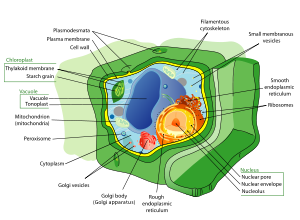The growing energy needs of our burgeoning population can only be tackled by advances in biotechnology. Lignin is a plant cell wall protein that reduces forage digestibility, pulping efficiency, and sugar release. Any improvement in lignin digestibility could have enormous impact on the utilization of grains like corn and is an area of active research. This article explains a novel computational approach to decipher the intricacies of lignin biosynthesis.
| Structure of a typical plant cell (Photo credit: Wikipedia) |
Potential ways of improving energy utilization include reduction in the indigestible cell-wall fraction, improvement in the digestibility of cell wall, reduction in the rate of GI passage and increased rate of absorption. Lignin reduction has been achieved using anti-sense genes to limit production of key enzymes on the lignin biosynthesis pathway. A genome wide comparative survey of various grain crops might identify genes that can be targeted by an anti-sense approach. Unfortunately Bt corn that has been genetically modified to express the Cry1Ab protein of Bacillus thuringiensis to kill lepidopteran pests, has a higher lignin content than non-Bt corn.
Breaking down cellulose strands by Lyocell process and cellulase activity inducers like Sophorose could improve the digestibility of cell wall. I wonder whether we could employ any of the tricks we cosmetic dermatologists use to create nanoparticles for increasing the absorption!

- Pragmatic Research That Builds and Travels - December 9, 2025
- Are we trapped in a matrix? - November 18, 2025
- Design Science Research in Healthcare: Bridging the Gap Between Ideas and Impact - November 11, 2025





